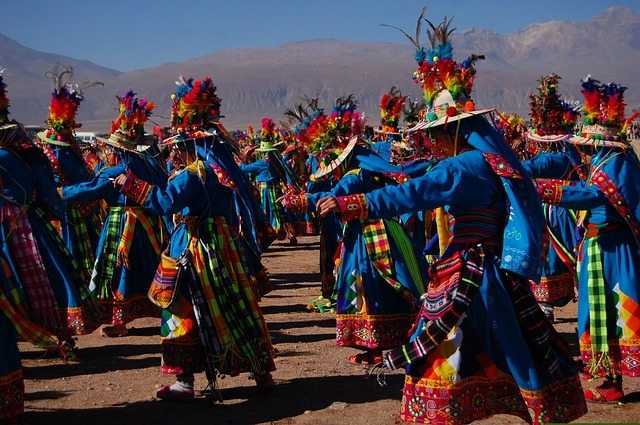India is a country where cultural diversity is celebrated at every occasion. Every state has a different language, different culture, and a different dance form which is very personal to it. It’s not like no other state performs the folk dance of other ones. But, the unique folk dance is the identity of its respective state. We can see the great impact of Westernized culture on today’s youth. But, even the lash of modernization couldn’t eliminate the importance of folk dance forms.
India is a country where you can find dance for every occasion, be it celebrations, thanksgiving, worship, everything. The list is very long but I am going to enlist the folk dances forms here. Save the rest for later.
Kathak

Kathak, a classical dance originating from Uttar Pradesh in India, is a harmonious blend of storytelling and rhythmic footwork. It’s an art form that narrates tales through graceful movements and expressive gestures, deeply rooted in Indian culture.
The Evolution of Kathak
From Storytelling to Courtly Splendor: Initially, Kathak was a storytelling medium, conveyed by traveling bards known as Kathakars. They depicted tales from Indian epics and mythology through dance and music. The dance form underwent significant transformations during the Mughal era, adopting more elaborate and sensuous styles, while still retaining its narrative essence.
Resilience through Changing Times: The arrival of colonial rule brought challenges and a decline in Kathak’s prominence. However, the dance form experienced a revival post-India’s independence, as efforts were made to rejuvenate and preserve this cultural gem.
The Dance Technique
Combining Rhythm and Expression: Kathak is distinguished by two primary elements: ‘Nritta’ (pure dance) and ‘Abhinaya’ (expressive dance). ‘Nritta’ focuses on intricate footwork and rhythmic patterns, while ‘Abhinaya’ tells stories through emotive gestures. The dance form is synonymous with rhythmic agility and dynamic spins, captivating audiences with its precision and elegance.
Musical Harmony: Accompanying Kathak is the rich tradition of Hindustani classical music, featuring instruments like the tabla and sitar. This music-dance relationship in Kathak is profound, creating an immersive experience for both performers and viewers.
Distinctive Styles: The Gharanas
Jaipur, Benares, and Lucknow Gharanas: Kathak’s diversity is reflected in its three main schools or ‘Gharanas’ – each with a unique approach. The Jaipur Gharana focuses on spirited footwork and spiritual themes. The Benares Gharana is known for its rich history and emphasis on rhythmic syllables. The Lucknow Gharana, influenced by the Mughal era, showcases expressive storytelling and delicate movements.
Costuming in Kathak
A Blend of Traditions: The attire for Kathak performers varies between Hindu and Muslim influences. Women might wear a specially draped sari or a long skirt with a choli, adorned with traditional jewelry. Men typically wear a silk dhoti. These costumes add to the visual splendor of the dance, enhancing the storytelling experience.
Kathak: A Cultural Beacon
Kathak stands as a testament to the enduring spirit of Indian classical arts. It’s a dance form that has adapted over centuries, absorbing various cultural influences while maintaining its core identity. Through Kathak, stories come alive, and India’s rich heritage is celebrated and preserved for future generations.
This overview captures the essence of Kathak, reflecting its historical journey, artistic nuances, and cultural significance. Kathak remains a dynamic and vibrant part of India’s artistic landscape, enthralling audiences with its timeless beauty and narrative depth.
Jhumur

Jhumar is a traditional folk dance indigenous to Jharkhand, an eastern Indian state. This lively and vibrant dance form is an integral part of the region’s cultural heritage and reflects the customs, traditions, and celebrations of the tribal communities that call Jharkhand their home. In this comprehensive exploration, we will delve into the historical background, elements, performance style, and cultural significance of the Jhumar dance of Jharkhand.
Historical Background and Evolution
Tribal Origins
Jhumar has its roots in the tribal communities of Jharkhand, including the Santhals, Oraons, Mundas, and Hos. It was originally performed during various tribal festivities, harvest celebrations, and rituals.
Cultural Preservation
Over the years, Jhumar has played a significant role in preserving the cultural identity of the tribal communities in Jharkhand. It has been passed down through generations and continues to be a cherished art form.
Performance Style and Elements
Expressive Movements
Jhumar is known for its expressive and rhythmic movements. Dancers perform intricate footwork, graceful hand gestures, and body movements that convey stories, emotions, and celebrations. The dance exudes a sense of joy and enthusiasm.
Traditional Attire
The attire worn by Jhumar dancers is reflective of the tribal culture of Jharkhand. Dancers often wear traditional tribal clothing, including colorful turbans, saris, and ornaments. The attire is an important aspect of the dance, adding authenticity and visual appeal.
Musical Accompaniment
Jhumar is accompanied by traditional tribal music. Instruments like the dhak (a type of drum), bansi (flute), and nagara (a cylindrical drum) are used to create the rhythmic and melodic backdrop for the dance. The music sets the tone and pace for the performance.
Jhumar has experienced a revival in recent years, with efforts made to promote and showcase this traditional dance form at state and national levels. Cultural organizations and government initiatives have played a role in preserving and promoting Jharkhand’s folk heritage.
Cultural Significance
Celebration of Tribal Life
Jhumar is a celebration of tribal life in Jharkhand. It portrays the daily experiences, rituals, and joys of the tribal communities. The dance serves as a medium to express gratitude for a bountiful harvest and to celebrate various life events.
Community Bonding
Jhumar is not just a dance; it is a community activity. It brings people together during festivals, weddings, and other social gatherings. It reinforces the sense of belonging and unity among tribal communities.
Preservation of Tribal Heritage
In a rapidly changing world, Jhumar serves as a means of preserving the rich cultural heritage of Jharkhand’s tribal communities. It ensures that traditional values, attire, and dance forms are passed down to future generations.
Contemporary Context
Cultural Revival
Fusion and Innovation
While traditional Jhumar remains popular, contemporary dancers and choreographers have also experimented with fusion performances, blending elements of the traditional dance with modern influences. This adaptability ensures that Jhumar remains relevant to a diverse audience.
Munda dance form got its name from karma tree. We can proudly call it a nature loving art as it gets started with the plantation of trees. A circle is formed by men and women, holding each other’s waists. Starting slowly, the dance keeps gaining momentum till the end on the beats of dhol.
Kuchipudi: An Enchanting Dance Form from Andhra Pradesh
Origins and Evolution
- Ancient Beginnings: Kuchipudi’s roots can be traced back to ancient Indian texts like ‘Natya Shastra’. It originated in the region now known as Andhra Pradesh.
- Medieval Era: The dance form developed under the patronage of kings and in temples. It was initially performed by male Brahmin dancers and evolved to include a wider range of performers.
- 17th Century Milestones: Key figures like Tirtha Narayanayati and Siddhendra Yogi were instrumental in shaping Kuchipudi into its present form. They introduced more structured dance dramas with themes centered around Hindu mythology, particularly Lord Krishna’s stories.
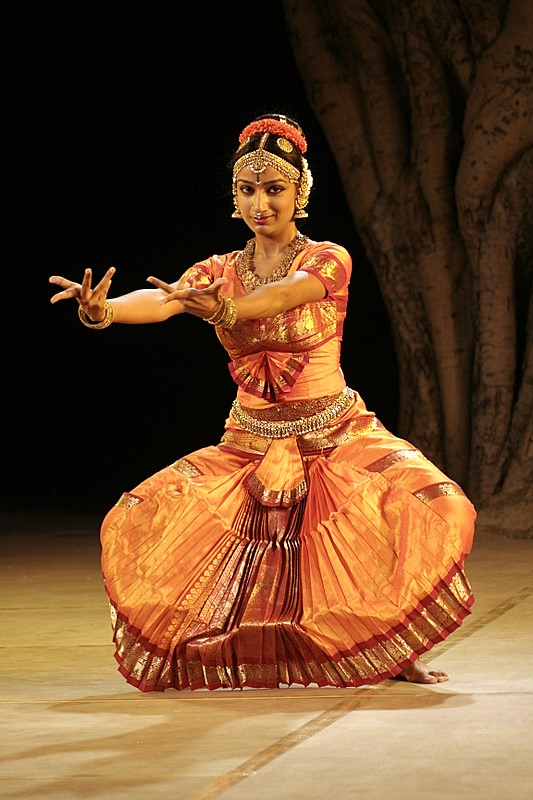
Characteristics and Style
- Vibrant Performance: Kuchipudi is characterized by dynamic movements, expressive eye movements, and hand gestures. It’s a blend of dance and drama, often telling stories from Hindu epics.
- Music and Rhythm: The dance is performed to Carnatic music with rhythmic beats. Instruments like the tabla and harmonium are commonly used.
- Traditional Attire: Dancers wear colorful costumes and elaborate makeup. Women typically wear a sari in a special style, while men wear a dhoti.
Contemporary Influence
- Revival and Adaptation: In the 20th century, Kuchipudi saw a resurgence, adapting to include female dancers and new themes. The establishment of dance academies helped promote and preserve the art form.
- Global Recognition: Today, Kuchipudi is recognized globally as one of India’s eight classical dance forms. It’s celebrated for its storytelling ability and is performed both in India and internationally.
Kuchipudi dance got this name from a village of Krishna district in Divi Taluka. It is one of the most popular dance form in Andhra Pradesh state.
Bhangra

Whenever we talk about Punjab, things that come to our mind are sarson da saaf, makki di Roti and of course Bhangra.
Bhangra is a symbol of joy and enthusiasm. The energetic moves of bhangra will make you very much willing to groove. Bhangra is performed on all the auspicious occasion of Sikhs.
Bhangra began in the agricultural heartlands of Punjab, India, as a dance to celebrate the harvest. It was a way for farmers to express their gratitude for a plentiful crop. Over time, Bhangra evolved beyond its agricultural roots to become a festive staple at weddings, festivals, and other significant events in Punjab. The dance has become a symbol of the vitality and resilience of Punjabi culture, reaching far beyond India to places around the world where the Punjabi diaspora has a presence.
Attire and Instruments
The clothing worn for Bhangra is as lively as the dance itself. Men often wear a turban, a long shirt, and a decorative waistcloth, all richly embroidered. Women’s attire typically consists of a colorful scarf, a traditional shirt, and loose pants, often accessorized with elegant jewelry. These costumes, with their bright colors and intricate designs, greatly enhance the visual impact of the dance.
Bhangra’s energy is amplified by traditional instruments like the Dhol, a two-sided drum, and the Tumbi, a single-stringed instrument. The Dhol, played with both a heavy and a light stick, sets the rhythm of the dance. Other instruments like Katos, Khunda, and Saaps also contribute unique elements to Bhangra performances.
Cultural Significance and Modern Influence
Bhangra is more than just a folk dance; it plays a crucial role in preserving and sharing Punjabi culture. It helps pass down traditions to younger generations and fosters understanding and inclusivity across cultures. Bhangra has influenced various music genres, particularly in the UK and South Asia, where it has blended with Western musical styles.
Bhangra as a Workout
Interestingly, Bhangra has also gained popularity as a form of exercise. The dance’s high energy and vigorous movements make it an appealing alternative to traditional gym workouts. Bhangra not only promotes physical fitness but also offers a fun and communal experience
Chhau Dance: A Lively Tradition from Eastern India
Chhau dance, a vibrant tradition from eastern India, is famous for its energetic performances and intricate masks. This dance form is popular in Jharkhand, West Bengal, and Odisha, each region offering a distinct style.
Three Unique Styles:
- Seraikela Chhau (Jharkhand): Known for its symbolic masks, this style involves expressive storytelling through dance.
- Purulia Chhau (West Bengal): Dancers wear elaborate masks representing mythological characters, adding a dramatic flair to their performances.
- Mayurbhanj Chhau (Odisha): This style stands out as it does not use masks, focusing instead on the dancers’ facial expressions and movements.
Cultural Essence: The Chhau dance is deeply rooted in local folklore and mythology, often depicting scenes from epics like the Ramayana and Mahabharata. It’s not just a dance but a cultural celebration, bringing communities together, especially during the spring festival, Chaitra Parva.
Music and Community: The dance is set to the rhythm of traditional drums and wind instruments, creating an infectious beat. Artists from various local communities contribute to the dance, whether through performance, music, or crafting the distinctive masks and costumes.
Modern Relevance: Chhau has adapted over time, maintaining its appeal and cultural significance. Recognized by UNESCO as an Intangible Cultural Heritage, efforts are ongoing to preserve this unique art form. Training centers and festivals help keep the tradition alive, attracting new generations to this dynamic dance form.
Bihu Dance: Celebrating Assam’s Spirit
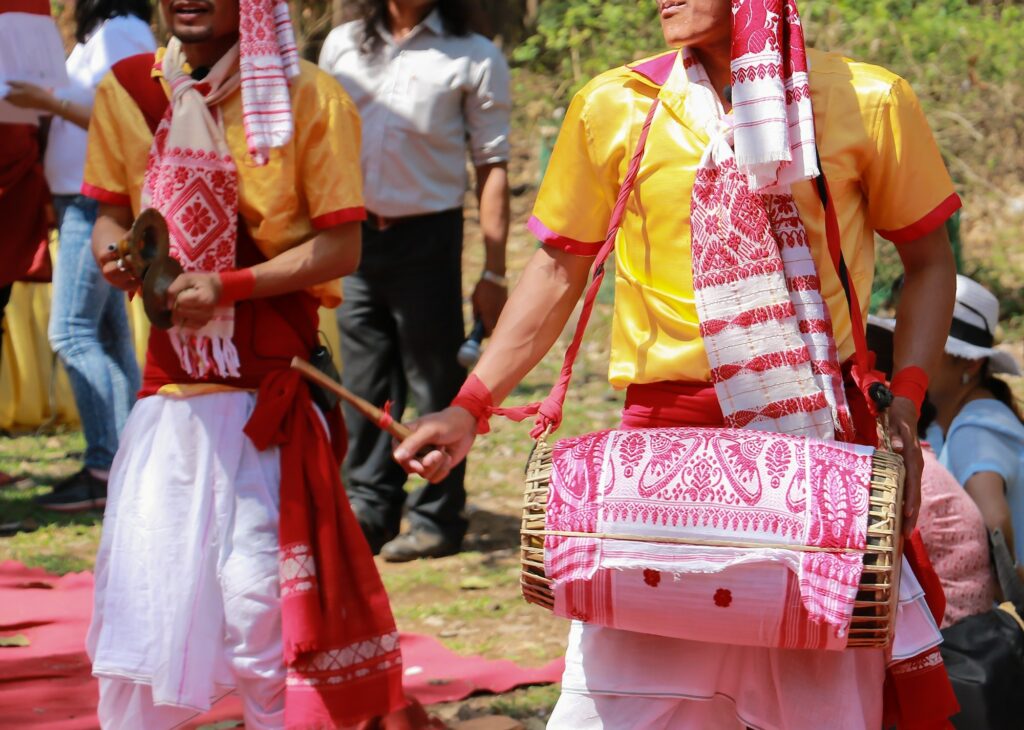
Bihu dance is an integral part of the Bihu festival in Assam, marking the Assamese New Year and the arrival of spring. It’s a lively dance that mirrors the joy and enthusiasm of the season.
Festive Movements: Characterized by brisk steps and swift hand movements, Bihu dance captures the essence of celebration and social gathering. Both men and women participate in this dance, often dressed in traditional Assamese attire, adding color and vibrancy to the festivities.
Musical Backdrop: The dance is accompanied by folk instruments like the dhol (drum) and flute, providing a rhythmic and melodious base for the dancers. The music and dance together create an atmosphere of joy and communal bonding.
A Community Affair: More than just a dance, Bihu is a community event that brings people together, symbolizing unity and shared happiness. It’s a time for Assamese people to celebrate their heritage and welcome the new season with hope and joy and eat Assamese food.
Garba: A Circle of Devotion

- Roots and Meaning: Garba, a name originating from ‘Garbha’ (womb in Sanskrit), is more than a dance; it’s a celebration of life itself. This dance form is a staple during the Navratri festival in Gujarat, embodying the spirit of life and the divine.
- The Dance of Spirituality: In Garba, dancers circle around a symbolic representation of the divine, like a lit lamp or an image of Goddess Durga, echoing the eternal cycle of life. This circular motion is a metaphor for the continuous flow of energy in the universe, with the Goddess as a constant, unyielding force.
- Cultural Attire and Evolution: The dancers, particularly women, don vividly colored outfits known as ‘Chaniya Choli’, adorned with intricate embroidery and mirror work. Men usually wear ‘Kediyu’. Over time, Garba has evolved, blending elements from Dandiya Raas and appealing to the younger, global audience.
- Worldwide Appeal: This dance has transcended its regional origins, gaining popularity across the globe, especially in areas with significant Indian communities.
Dandiya Raas: Rhythmic Echoes of Tradition
- The Rhythm of Good Over Evil: Dandiya Raas is a dynamic dance, symbolizing the mythical battle between Goddess Durga and the demon Mahishasura. Using decorated bamboo sticks, the dancers’ movements mimic a martial dance, celebrating the triumph of virtue and righteousness.
- Complex Moves and Coordination: This dance form is characterized by its use of sticks and complex, synchronized movements. The dancers form concentric circles, moving in harmony, creating a mesmerizing spectacle.
- Traditional Garb: The attire for Dandiya mirrors that of Garba, with vibrant colors and traditional designs, adding to the visual spectacle of the dance.
Cultural Impact and Celebratory Spirit
- More than Just Dance: Both Garba and Dandiya Raas are deep-rooted in spiritual and religious traditions. They are essential parts of Navratri, a festival honoring the divine feminine.
- Bonding Communities: These dances are powerful tools for social bonding, bringing together people from various backgrounds in a joyous celebration.
- Adapting with Time: While they remain true to their roots, both Garba and Dandiya Raas have embraced modern elements, making them popular even in contemporary cultural festivals worldwide.
Lavani: The Expressive Dance of Maharashtra
Historical Roots and Evolution
- Origin and Growth: Lavani emerged as a prominent dance form in the 18th and 19th centuries in Maharashtra. Initially performed to boost the morale of soldiers, it later flourished in the royal courts of the Peshwas.
- Cultural Significance: Originally a form of entertainment for royal audiences and troops, Lavani evolved over time. Its growth was significantly influenced by the socio-political environment of Maharashtra during the Peshwa rule.
Themes and Styles
- Diverse Themes: Lavani encapsulates two main themes. Nirguni Lavani, which delves into philosophical and devotional aspects, and Shringar Lavani, known for exploring more sensual and emotional themes.
- Shringar Lavani: This style is particularly noted for its portrayal of intricate human emotions and relationships. It often reflects the experiences and lives of women during the Maratha regime, especially those left behind by warriors.
Costume and Performance
- Traditional Attire: Performers traditionally wear the nauvari, a nine-yard saree, along with an array of jewelry. This attire is not only culturally significant but also adds to the vibrancy of the performance.
- Musical Accompaniment: Lavani is performed to the energetic beats of the Dholak, along with other instruments like Manjeera and Harmonium, contributing to its lively and dynamic nature.
Social Context and Modern Adaptations
- Changing Perceptions: Initially associated with lower social strata, Lavani faced stigmatization. Over time, its portrayal and content were modified to align with changing societal norms.
- Contemporary Influence: Despite its traditional roots, Lavani has adapted over time, finding its way into modern theatres and Bollywood, while still retaining its core elements of storytelling and expressive dance.
Kathakali
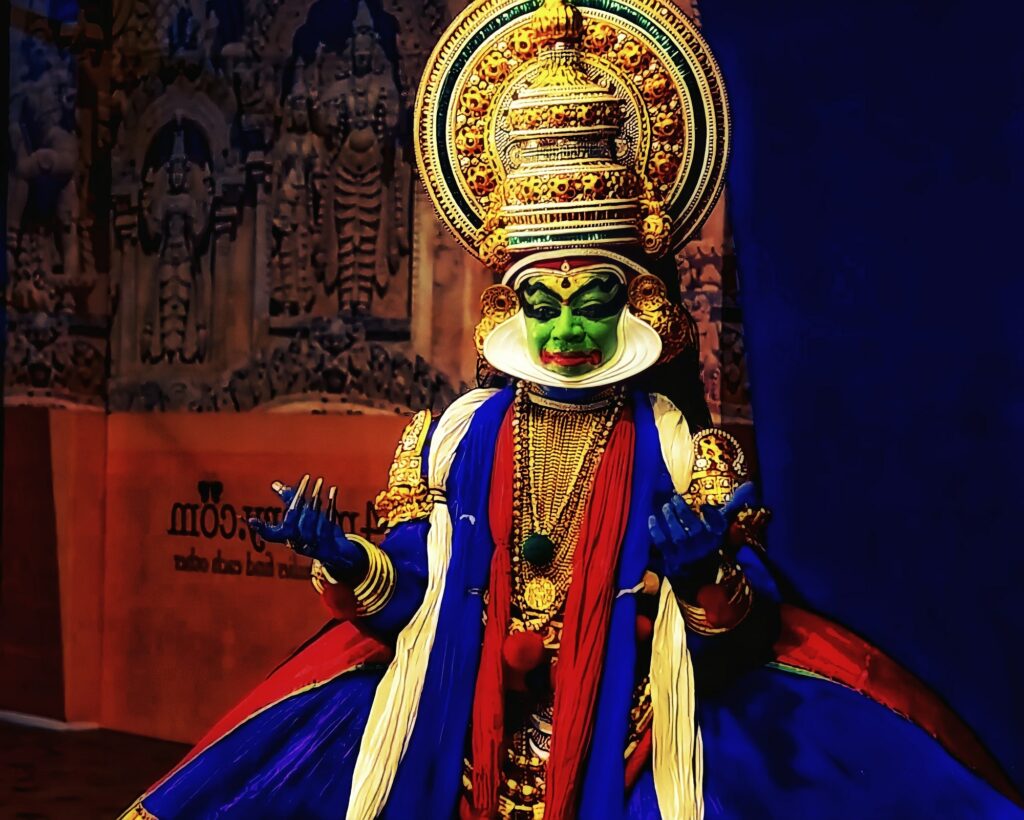
Kathakali is a classical Indian dance-drama with its roots in the state of Kerala. This art form is celebrated for its distinctive makeup, intricate costumes, and detailed gestural storytelling. In this comprehensive guide, we will delve into the historical background, evolution, performance style, storytelling, and its contemporary context, providing you with a complete understanding of Kathakali.
Historical Background and Evolution
Roots in Temple Arts
Kathakali’s origins can be traced back to ancient temple and folk arts of Kerala, including Kutiyattam and Krishnanattam. These early forms heavily influenced Kathakali’s development, particularly in terms of its dramatic and narrative elements.
Integration with Martial Arts
Elements of Kalaripayattu, an ancient martial art form native to Kerala, are also embedded in Kathakali. This integration adds dynamism and power to the dance, as well as a unique flair that sets it apart from other classical dance forms in India.
Performance Style and Elements
Vivid Makeup and Costumes
One of the most visually captivating aspects of Kathakali is its vibrant makeup and costumes. Each character is represented by distinct colors and styles, allowing the audience to easily identify gods, demons, heroes, and more. This elaborate makeup and costume design play a pivotal role in conveying the nature and attributes of each character.
Significant Use of Mudras
Hand gestures, known as “mudras,” are at the heart of Kathakali’s expressive language. Each mudra represents specific emotions, objects, or narratives. When combined with precise eye movements, referred to as “netrabhinaya,” these gestures enable the performers to convey a wide range of emotions and stories.
Athletic Footwork and Body Movements
Kathakali performers showcase remarkable strength and agility. The dance includes intricate footwork and body movements that are synchronized with the rhythmic beats and music of the performance. This physicality adds an element of athleticism that sets Kathakali apart from other classical dance forms.
Storytelling and Repertoire
Mythological Themes
Traditionally, Kathakali performances revolve around stories from Hindu epics such as the Ramayana and the Mahabharata. These performances are often extensive, lasting throughout the night and concluding at dawn. Modern renditions, however, tend to be shorter in duration.
Diverse Repertoire
While deeply rooted in Hindu mythology, contemporary Kathakali troupes have expanded their repertoire to include themes from various sources. This inclusivity encompasses stories from Christianity and works of Western authors like William Shakespeare, demonstrating the art form’s adaptability.
Contemporary Context
Inclusivity and Adaptation
Originally performed exclusively by all-male troupes, Kathakali has evolved with changing times. Today, it includes women performers, showcasing its adaptability and openness to new influences. Kathakali remains a living tradition, seamlessly blending tradition and modernity.
Odissi
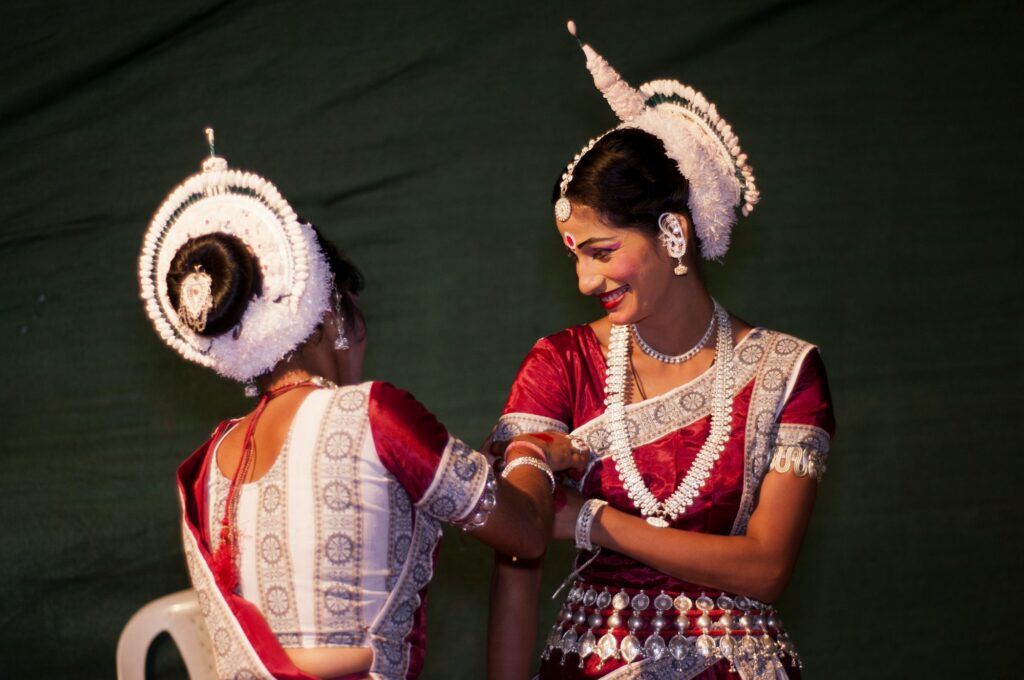
Odissi is a classical Indian dance form that originates from the eastern state of Odisha. This centuries-old art form is known for its grace, intricate mudras (hand gestures), storytelling through expressive movements, and the use of rich music and rhythm. In this comprehensive exploration, we will delve into the historical background, elements, repertoire, and the contemporary relevance of Odissi.
Historical Background and Evolution
Ancient Origins
Odissi traces its roots to the ancient temples of Odisha, where it was performed as a form of worship and storytelling. It has its origins in the traditional dances of “Devadasis,” who were temple dancers dedicated to deities.
Revival and Modernization
During the colonial era, Odissi faced a decline. However, in the mid-20th century, it experienced a revival led by pioneers like Guru Kelucharan Mohapatra and others. They reconstructed and codified the dance, bringing it back to the stage.
Performance Style and Elements
Graceful Movements
Odissi is celebrated for its graceful and fluid movements. Dancers use soft, lyrical steps, and the upper body remains steady while the lower body creates intricate patterns. The overall effect is one of elegance and charm.
Mudras and Abhinaya
Mudras, or hand gestures, play a crucial role in Odissi. Each mudra conveys specific emotions, characters, or objects, allowing dancers to tell stories with precision. Abhinaya, or expressive facial and body movements, complements mudras to convey a wide range of emotions and narratives.
Music and Rhythm
Odissi performances are accompanied by rich music, often featuring traditional Odissi instruments like the mardala (a percussion instrument), flute, and violin. The rhythmic element, known as “tala,” adds depth and complexity to the dance, creating a harmonious blend of movement and music.
Repertoire and Themes
Traditional Themes
Odissi traditionally draws inspiration from Hindu mythology, featuring stories from epics like the Ramayana and the Mahabharata. Dancers portray various characters, gods, and goddesses, captivating audiences with timeless tales.
Contemporary Themes
In modern Odissi, artists have embraced a broader spectrum of themes, including social issues, abstract concepts, and non-religious narratives. This evolution has made Odissi a dynamic and versatile art form, relevant to contemporary audiences.
Contemporary Context
Global Appeal
Odissi has gained international recognition and appeal. Dancers and institutions have collaborated globally, showcasing the art form on international stages. This exposure has enriched Odissi by incorporating diverse influences.
Preservation and Innovation
While Odissi maintains its traditional essence, contemporary dancers and choreographers continually innovate, pushing boundaries and exploring new expressions within the art form. This blend of preservation and innovation ensures the vitality of Odissi for future generations.
Rauf Dance
Occasion and Significance:
- Rauf is primarily performed during Eid celebrations, which are significant religious festivals for the Muslim community in Jammu and Kashmir.
- It serves as a means of expressing communal joy and unity during these festive occasions.
Dance Movements:
- Rauf is characterized by graceful and synchronized movements, with dancers forming a circle or semi-circle.
- Dancers often create patterns with their hands and feet, with each movement symbolizing various aspects of the celebration and local culture.
Costumes:
- Dancers wear traditional Kashmiri attire, including phirans (long robes), turbans, and traditional accessories, adding a touch of cultural authenticity to the performance.
Hikat Dance
Female-Centric Tradition:
- Hikat is a unique dance form as it is exclusively performed by women.
- It provides women with a platform to express their emotions, stories, and cultural heritage through dance and song.
Musical Accompaniment:
- The dance is accompanied by traditional folk songs, often sung by the women themselves.
- The lyrics of the songs usually reflect the themes of love, nature, and daily life in the hilly regions of Jammu and Kashmir.
Costumes and Jewelry:
- Women adorn themselves with traditional attire, which includes colorful dresses, headscarves, and intricately designed jewelry.
- The costumes and ornaments vary by region and reflect the diverse culture of Jammu and Kashmir.
Mandjas Dance
Cultural Significance:
- Mandjas dance is closely tied to the Gaddi community, who inhabit the hilly regions of Himachal Pradesh.
- It is an essential part of their cultural and social life, often performed during weddings, fairs, and other festive occasions.
Group Dynamics:
- The dance is performed in groups, with dancers forming a circle.
- The coordination and synchronization of movements demonstrate the sense of unity and togetherness within the Gaddi community.
Traditional Instruments:
- Mandjas is accompanied by traditional Gaddi music, which includes instruments like the dhol, shehnai (a type of flute), and damru (a small drum), creating a lively and melodious atmosphere.
Kud Dandi Nach
Dance Implements:
- Kud Dandi Nach involves the use of sticks called “dandi” by the dancers.
- The sticks are used in rhythmic patterns, enhancing the visual appeal of the dance.
Expression of Heritage:
- This folk dance serves as a cultural expression of the Kurmi community’s heritage and way of life.
- It allows the community to celebrate their identity and traditions through vibrant dance and music.
Traditional Music:
- The dance is accompanied by traditional folk songs and music, often featuring the energetic beats of the dhol and other indigenous instruments.
Sattriya Dance
Historical Significance:
- Sattriya dance was developed in the sattras or monasteries of Assam primarily as a form of worship and devotion.
- Shankaradeva, the saint and cultural icon, played a crucial role in systematizing and popularizing Sattriya dance.
Distinctive Features:
- Sattriya incorporates elements of drama, poetry, and music into its performances, making it a comprehensive art form.
- The dance emphasizes Bhakti (devotion) to Lord Krishna and often portrays his stories from the Bhagavad Gita and other scriptures.
Costumes and Instruments:
- Sattriya dancers wear traditional Assamese attire, including ornate Mekhela Sador for women and Dhoti Kurta for men.
- Musical accompaniment includes traditional Assamese instruments like the khol (a drum), flute, and cymbals.
Recognition and Revival:
- Sattriya dance received recognition as one of the eight classical Indian dance forms by the Sangeet Natak Akademi, India’s national academy for the performing arts.
- Efforts have been made to preserve and promote this traditional art form, ensuring its continuation and growth.
Manipuri Dance
Historical Roots:
- Manipuri dance finds its origins in the rich cultural traditions of Manipur, often referred to as the “Jewel of India” for its diverse artistic heritage.
- It is deeply connected to the Vaishnava faith and is characterized by its spiritual and ritualistic nature.
Jagoi and Cholom:
- Jagoi is the lasya aspect of Manipuri dance, known for its graceful, lyrical, and fluid movements that convey delicate emotions and stories.
- Cholom, on the other hand, represents the tandava aspect, characterized by energetic and rhythmic footwork.
Ras Lila:
- A significant theme in Manipuri dance is the portrayal of the Ras Lila, which depicts the divine love story of Lord Krishna and Radha.
- This dance form is a harmonious blend of devotion and artistry, where each movement and expression has a profound spiritual significance.
Costumes and Instruments:
- Manipuri dancers wear vibrant and colorful costumes, often with elaborate headgear and ornaments.
- Traditional Manipuri instruments like the pung (a drum) and kartal (cymbals) accompany the dance, providing a distinct musical flavor.
Mohiniattam Dance
Mythical Inspiration:
- Mohiniattam is named after Mohini, a mythical enchantress and avatar of Lord Vishnu.
- It is often associated with the feminine grace and allure of Mohini, reflected in the dance’s movements.
Costumes and Makeup:
- Mohiniattam performers wear white and gold-trimmed sarees, known as the “Murali.”
- The makeup is minimalistic, highlighting the natural beauty of the dancers with minimal jewelry.
Rhythmic Patterns:
- Mohiniattam employs rhythmic patterns unique to Kerala, including the use of rhythmic syllables from the Maddalam drum, which provide a distinct Kerala flavor to the dance.
- The performance often includes intricate and graceful hand gestures (mudras) and facial expressions (abhinaya).
Themes and Expressions:
- Mohiniattam often explores themes of love, devotion, and storytelling from Hindu mythology, particularly focusing on the female perspective.
- The dance’s graceful movements and expressions convey a range of emotions, making it a captivating and evocative art form.
